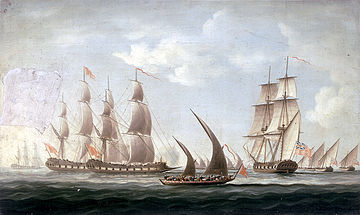
The gallivat (or galivat, or gallevat, or gallowet, or gallouet) was a small, armed boat, with sails and oars, used on the Malabar Coast in the 18th and 19th centuries. The word may derive from Portuguese "galeota" or alternatively, from the Maratha "gal hat" ship. Hobson-Jobson has an extensive discussion of the origins of the term and its usage.[1]
The gallivat typically had one or two masts with a lateen sail, and some 20 benches for oarsmen, one on each side. They were generally under 70 tons (bm) in size, and had a prow much like that of a grab.
One of the ablest admirals of the 18th Century Maratha Navy, Kanhoji Angre (a.k.a. Angria), made great use of gallivats. Generally, each of his grabs would have an attendant gallivat, both to tow it in calms and to carry extra men.[2]
On December 27, 1735 Angre attacked the East Indiaman Derby off Suvarnadurg. He deployed nine galleys, five grabs, and fifteen gallivats. Derby eventually struck her colours after having seven men killed and five wounded. Angre kept the surviving crew prisoners for 11 months until the Governor of Bombay ransomed them.[3]

In 1754, a listing of Sidhi vessels seized by the EIC and held at Surat in 1759 gives the names of seven gallivats. The largest, Manzul, had a length of 44 feet, a breadth of 17 feet, and a hold depth of 4 feet. The length and breadth measurements translate into a burthen (bm) of 52 ton. The smallest gallivat, Ram Chand, had a length of 29 feet, a breadth, of 13 feet, a hold depth of 4 feet, yielding a burthen of 19 tons.[4]
A gallivat that the EIC captured in 1775 measured 84 feet in length, and 24 feet in breadth, which yields a burthen of 213 tons. She had a single, forward-raked mast, and 24 oars, and carried ten 6-pounder guns.[5] This would seem to be at the upper end of the size for a galivat, and represent a vessel more in the range of sizes for a grab.
- ^ Yule & Burnell (1886), pp. 361–3.
- ^ Sutton (2010), p. 49.
- ^ Hackman (2001), p. 85.
- ^ Barendse (2009), p. 392.
- ^ United Service Magazine, Vol. 140, (1876), p.307.